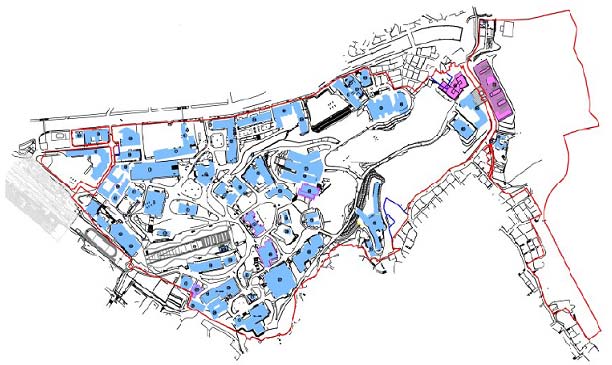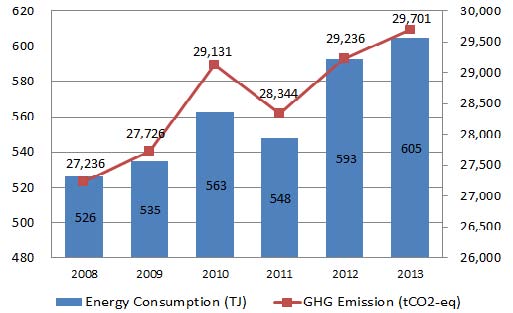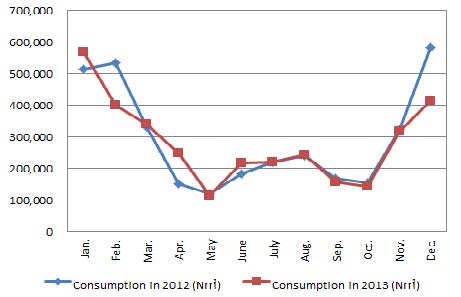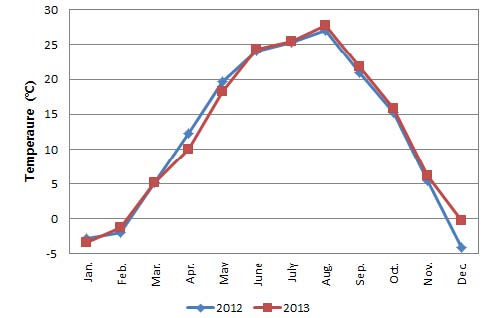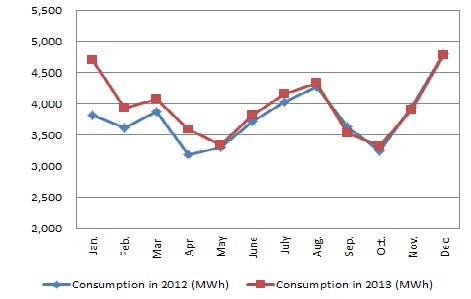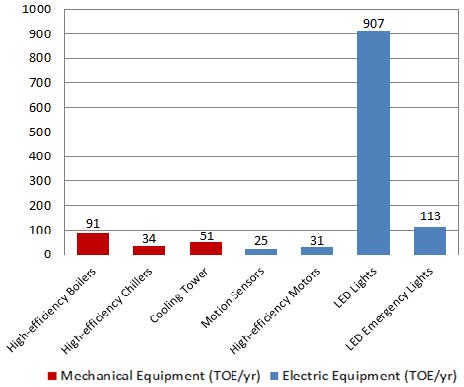
Methods to Reduce Greenhouse Gas for University Buildings to Make a Low-Carbon Green Campus
University buildings are energy-guzzling facility that consume more than 10,000TOE within a campus annually. Even the consumption is on an upswing trend. Behind such high consumption are there cheap power rates for education facility, lack of high-efficiency equipment and ever-increasing use of various information equipment. Being keenly aware that greenhouse gas emission increases due to such rise of energy consumption, the present study carried out a case study. In the case study, the study chose the buildings of E university from top 10 universities that consume energy most in Seoul and examined the current status of their energy consumption and greenhouse gas emission. And then it set the reduction target of greenhouse gas by year. Putting aside a middle and long-termed strategy for later endeavor, it first established the 1st year's implementation plan (2014) for energy saving and greenhouse gas reduction with limited budget and according to greenhouse gas reduction target. The plan is specified as follows. Targets for energy saving are mainly divided into two sectors: machine equipment and electric equipment. 7 ideas were proposed. Three ideas to improve machine equipment are to replace with high-efficiency boilers and chillers and to adjust the position of the cooling tower. By doing so, it was estimated that energy could be saved by 176.34TOE in total and greenhouse gas could be reduced by 370.771tCO2-eq. Four ideas to improve electric equipment include the replacement with LED lights, LED emergency lights and high-efficiency motors and the installation of motion sensors. It was calculated that such replacement could conserve 1,076.08TOE (electric energy) and reduce 2,181.420tCO2-eq (greenhouse gas).
Keywords:
University Building, Low-Carbon Green Campus, Greenhouse Gas, GHG reduction technology1. Introduction
1.1. Background and Purpose of the Study
Seeing global warming and various unusual weathers due to the former as main factor, the world have taken active actions against global warming. Since 1988 when World Meteorological Organization(WMO) and United Nations Environment Programme (UNEP) jointly “Intergovernmental Panel on Climate Change”, which is an international council under UN, according the resolution of UN General Assembly, the world has adopted ‘United Nations Framework Convention on Climate Change (UNFCCC)’ and laid out greenhouse gas reduction agreements such as Kyoto Protocol and Bali Road map to cope with climate changes.
Since South Korea was classified as developing country, it was excluded from the country list for mandatory reduction. But It accepted the request from some advanced country for voluntary participation and set the targets of “30% reduction for estimated emission BAU by 2020 and 50% reduction for estimated emission BAU by 2050” in the 15th Conference of the Parties, Copenhagen in 2009 and declared it to the international societies. To keep abreast with the global societies, Korea legislated 『Framework Act on Low Carbon Green Growth』 in 2010 and notified 『Guidelines of the Operation of Target Management Scheme』 according to Article 42 of the foregoing act and its implementing ordinances 26. Accordingly, the Korean government designated the companies of large energy consumption and greenhouse gas emission as control target every year, set targets for them and monitors if they try to fulfill them.
As of 2013, 16 universities were designated as control target among 51 entities subject to target management system in building sector [1]. Those universities are energy-guzzling institutions that consume more than 10,000TOE within campus annually. According to 2009 university energy consumption survey as seen in Table 1, the top ranking A university located in Seoul used up 34,259TOE annually. Behind the excessive energy consumption, however, there are instigating factors such as cheap power rates for education facility, lack of high-efficiency equipment, ever-increasing use of various information equipment and insufficient awareness of ownership. Such overconsumption is causing a serious problem. Recognizing the issue, some universities are making efforts to establish ‘Low-carbon green campus’ in order to cope with related greenhouse gas reduction laws and regulations.
The present study selected as object for case study on the E university in top 10 university (Table 1) [2] in Seoul that consume excessive energy consumption and aimed to draw out plans to help the university save electric energy consumption and reduce greenhouse gas and to propose a element technical guideline to build a low-carbon green campus.
1.2 Scope of Study and Method
With E university, in Seoul as object of case study, which is subject to the control target list of 『Greenhouse Gas/Energy Target Management System』, the present study examined its status of buildings, greenhouse gas sources and emission. Based on the collected data, it estimated the reduction of greenhouse gas by plan that is practical and quantifiable and proposed a plans to make a low-carbon green campus under greenhouse gas reduction system in order to achieve greenhouse gas reduction targets.
To carry out the study, the following methods and contents are employed.
1) It selected E university usable for data collection and examined the current status of greenhouse gas emission sources, new establishment and expansion of emission facility and characteristics.
2) It examined the current status of energy use, greenhouse gas emission and characteristics in E university.
3) It examined the previous greenhouse gas reduction plans of E university and other universities help E university attain greenhouse gas reduction goals as a control target subject to greenhouse gas/energy target management.
4) It derived practical and quantifiable greenhouse gas reduction plans.
5) Based on the derived plans, it estimated greenhouse gas reduction, initial investment and payback period of each plan.
6) Based on the calculated data, it set yearly greenhouse gas reduction goals and made a final proposal to help E university establish low-carbon green campus.
2. Theoretical Review
2.1. Definition of Low-Carbon Green Campus
With ‘sustainability’ as a core value, low-carbon green campus means to make university a low-carbon society through a variety of efforts to reduce greenhouse gas on campus. University is a place to foster future human asset.
Aiming to cultivate human talents to lead green growth era, it is responsible for saving energy and reducing greenhouse gas. Table 2 shows two effects of low-carbon green campus: educational effects and response to climate changes [3]. Low-carbon green campus is part of efforts that existing universities have made to make environment -friendly campus and eco-campus. However, low-carbon green campus can be differentiated from the previous ones in that the former is bestowed with the principles of ‘sustainability’ and ‘low-carbon’ while the latter has focused on building greenery or saving resources. However, eco-campus movement is also moving fast toward low-carbon green society to cope with climate changes.
2.2. Greenhouse Gas/Energy Target Management System
Greenhouse gas/energy target management system is a system to achieve the national greenhouse gas reduction goals, to cope with climate changes and to create a driving engine for global greenhouse gas reduction. To do so, it sets the targets of greenhouse gas reduction and energy conservation for control targets that use excessive energy and emit excessive greenhouse gas and manages the status of implementation. The government sets emission targets with mutual discussion with the control targets and helps them achieve the targets through incentives and penalties (correction order and fine). Therefore, it eventually aims to run an effective system to reduce greenhouse gas and save energy as well as enhance the competitiveness of companies.
A control target is designated every year. The criteria is a company or workplace that has consumed energy more than designated (yearly average gross for the last 3), as in Table 3, according to 『Framework Act on Low Carbon Green Growth』 and 『Guidelines for the Operation of Target Management Scheme』. Any entity subject to it is monitored as control target.
3. Summary of E university
3.1. Basic Information of E University
Located in Seodaemun-gu, Seoul, the case university was established in 1886 and has grown through several leaping stages to a university that leads to genuine challenge and adventure. The campus and buildings are as big as 546,389m2 and 458,963m2, respectively and about 20,000 students and 2,000 educational workers are in the school consisting of 75 buildings.
According to Article 29 of 『Framework Act on Low Carbon Green Growth』 and Article 20 of 『Guidelines for the Operation of Target Management Scheme』, it was first designated as control target in June, 2012. And since then, it has been submitting greenhouse gas implementation plan, performance report and specification in the national report form every year to the government.
The control target consists of 54 buildings including museum, engineering hall, dormitory, research hall, education and culture hall, information and telecommunication hall, general science hall and central library. They are shown in the block plan (Figure 1).
3.2. Greenhouse Gas Emission Sources
The greenhouse gas emission sources of E university can be mainly divided into two as shown in Table 4: direct emission sources (stationery emission facility and mobile emission facility - vehicles-) and indirect emission source from external electric power purchase.
Direct greenhouse gas emission sources in Scope 1 are ones owned or controlled by E university while indirect greenhouse gas emission sources in Scope 2 are ones not owned or controlled by other companies (electric power and heating production) and thus varying depending upon the activities in workplace.
3.3. The Current Status of Energy Consumption and Greenhouse Gas Emission of E University
As seen in Figure 2, the energy consumption and greenhouse gas emission of 54 buildings of E University steadily increased from 2008 to 2013, except a sharp increase in 2010, every year. The greenhouse gas emission in 2013 is 29,701tCO2-eq, increasing by 2% from 2012.
It is assumed that the sharp rise in 2010 is due to unexpected intense heat and cold wave in the year, which lead to significantly more use of cooling and heating energy consumption owing to high fluctuation of temperature [4].
Figure 3 shows the monthly use of LNG of E university from 2012 to 2013. As seen in the graph, consumption behavior during summer is not much different between two years but quite different during winter and spring season with March as starting point. It can be explained by the use of LNG, which is fuel for cooling energy and considerably affected by external temperature. Looking at Figure 4 that shows the meteorological data of both years, it can be known that temperature changes of winter and spring are similar to those of the consumption of LNG shown in Figure 3.
As seen in Figure 5, it turned out that E university consumed more electricity from January to April in 2013 than during the same periods of 2012. It is because two more facilities (using electricity) had been built in January, 2013 and thus overall consumption of electricity increased. But in May, some electricity-consuming facilities of the library were replaced with those using gas, which led to the decrease of electricity consumption. Therefore, both years had got back to similar trend of electric consumption.
3.4 Energy Intensity Analysis
The gross floor area of the buildings of the control target is 471,997 m2. Thus the gross energy consumption of 2013 was calculated into average energy intensity, as in Table 5, according to the gross floor area.
Table 6 shows the energy intensity [5] of total 545 universities by the size of building, which was surveyed under the supervision of the Ministry of Commerce, Industry and Energy in 2002. The energy intensity of E university for fuel and electric power are 314 MJ/m2.yr and 101kWh/m2.yr, respectively. As seen in Table 6, when gross floor area is greater than 50,000m2, the fuel energy intensity of E university is lower by 37% than the average fuel energy intensity of other universities (502MJ/m2.yr) but the electric energy intensity of E university is higher by 15% than the average electric energy intensity of other universities (88kWh/ m2.yr). Accordingly, it explains that E university used electric power more than the average of other universities while using fuel less than the average of other universities.
4. Greenhouse Gas Reduction Plan of E University
4.1. Greenhouse Gas Reduction Goal
To cope with global climate changes, the Ministry of Transportation sets and notifies emission allowance and greenhouse gas climate allowance every year for entities that emit excessive greenhouse gas through mutual discussion with them in order to achieve the national target of 30% BAU reduction by 2020. The total amount of greenhouse gas that those entities are bound to reduce in 2014 is 562,000tCO2-eq, which is 2.1 times larger than 268,000tCO2-eq of 2013. The reduction amount of building sector is 464,000 tCO2-eq in 2014, which is 2.3 times greater than 201,000tCO2-eq of 2013 [6].
E university, which is in the list of control target, is also assigned 28,000tCO2-eq of greenhouse gas emission allowance and 546TJ of energy consumption allowance for 2014 as seen in Table 7. With the incremental amount by building extension considered, E university is estimated to emit 30,545tCO2-eq of greenhouse gas. Therefore, it must reduce 2,545tCO2-eq of greenhouse gas in 2014.
Although E university was designated as control target in 2012, it hasn't been able to meet the reduction goal yet. However, it is willing to implement reduction plan from 2014, carrying a sense of responsibility as energy-guzzling educational institution to be born again into a low-carbon green campus. Accordingly, the institution has set reduction targets by year (for 5 years) and prepared a plan, as proposed in Table 8, to accomplish the targets.
In the first year, it will reduce 2,552.191tCO2-eq first to meet the reduction target of 2014. Therefore, it set a plan to reduce the estimated emission of 2014 by 8.4%. After that, E university will reduce 500tCO2-eq every year until 2018, when it aims to meet the final target reduction of 15% in total.
4.2. Greenhouse Gas Reduction Plan
The buildings of E university have been built step by step over years. Therefore, considerable number of its heat power and electric power facilities are inefficiency equipment because they were developed when energy was low in the past. It is necessary to replace them with high-efficiency equipment for better performance.
To build a low-carbon green campus, the present study derived a plan of greenhouse gas reduction in university buildings with practical and quantifiable plans. The greenhouse gas reduction ideas are based on DB [7] of inefficiency equipment, which was survey before, and ‘Guidebook to Building Low-Carbon Green Campus’.
The improvement plans for machine equipment and electric equipment were first made as action plans to reduce the emission since it was considered that they could be workable within the limited budget. And the estimations of energy reduction, greenhouse gas reduction, initial investment and payback period were calculated upon the above-mentioned plans as seen in Table 8.
It was decided that the improvements which are considered to be executed with a middle or long-term plans would proceed along with yearly plans.
4.3. Improvement Plan for Machine Equipment
Most of the current hot water heating steam boilers in E university were installed between 1991 and 2003. Therefore, their durability life has already expired, so they are very inefficient in performance due to deterioration. When they are replaced with high-efficiency boilers, it can be expected to save energy through improved efficiency. Accordingly, greenhouse gas reduction and payback period were placed in calculations and the following estimation of greenhouse gas reduction was brought forth for 4 buildings as in Table 8 and 9.
Efficiency was selected to be 94% according to the standard rate of 1st class boiler. And monthly utility bills of 2013 were employed to derive fuel saving. As a result, estimation was made that LNG saving of the four buildings was 87,102Nm3/yr (90.85TOE/yr), which allows to predict 192.992tCO2-eq of greenhouse gas reduction and 72.29million won per year of saving amount. (Average unit price [830won] of average heat between January 1, and Mar 25, 2014 for cooling energy was applied based on revised utility fee criteria on January 1, 2014)
Referring to price index formation books [8], material cost was set for a high-efficiency boiler of the equivalent capacity to the previous one. As a result, it was calculated to cost 408.97million won (Table 8) to replace the existing boilers and to take 8.06years to get paid back from the replacement.
It was decided that absorption chiller would replace old ones in the dormitory and the students’ culture hall first of all due to budgeting strains. The existing absorption chillers in the two buildings were installed in 1997 and 1998, respectively. Like the boilers, therefore, they are old and inefficiently performing, with COP as low as 0.8.
Recently, high-efficiency chiller has technologically developed to the level where COP can increase over 1.5 due to the application of high-efficiency solution plate type heat exchanger, condensed refrigerant heat recovering device, solution exhaust gas heat exchanger and others. These technologies were applied to two buildings and estimated to save 17,215Nm3/yr (17.96TOE/yr) and 71,003kWh/yr (16.33TOE/yr) for LNG and electric power, respectively. Namely, it was estimated to save a total of 34.29TOE/yr of electricity and reduce 71.249tCO2-eq of greenhouse gas. When they are converted to monetary unit, saving amount is 19.76million won per year. Material cost estimated from price index formation books was applied to calculation and 245.40million won was turned out for initial investment. And the average payback period of two buildings was 14.32years. Since this improvement takes longest payback period among year-1 implementation plans, a deep discussion with the university seems to be needed.
In Science Hall, 3 chillers (180usRT) and one centrifugal water chiller (180usRT) are in operation. Since the positions of 4 cooling towers supported buy those equipment are not same, only one tower is operating, which is not very sufficient. This inefficiency lowers cooling capacity and even overall COP. Moreover water is in poor management, so thermal conduction is severely resisted due to Ca and Mg in water, which decreases the heat exchange capacity of the tower. For the reason, it was thought necessary to adjust the installation height of the cooling towers to maintain the pressure of refrigerant at a proper level, secure proper amount of coolant and manage the temperature properly, to improve COP of the freezers and thus save energy.
By calculation, it was estimated that LNG can be saved as much as 27,039Nm3/yr (28.20TOE/yr) and electricity can be less consumed as much as 99,989 kWh/yr (23.00TOE/yr). As estimated greenhouse gas reduction turned out to be 106.530tCO2-eq, saved amount is 30.14million won per year. Previous analysis reports were used to estimated initial investment at 50.00million won and 1.66years was estimated as payback period. As a result, it was thought worthwhile to invest in this plan.
4.4. Improvement Plan for Electric Equipment
The first plan for greenhouse gas emission reduction in electric power sector was to install motion sensors (counter sensors). Although E university has already installed the sensors in some of rest rooms in an effort to save energy, most of the rest rooms are not equipped with the sensors. Therefore, most of lights are still on even when users are not in them, which has become a energy wasting factor.
A motion sensor detects far infrared light radiated from a human body and control light on/off for users to come in and go out. By doing so, a rest room with the sensor can save energy and reduce greenhouse gas.
60 times a day was set as the average use per a rest room in 22 buildings including Education and Culture Hall. Sometimes, more than one user uses it at the same time, so there is overlapping. However, here, we consider the use by outsiders and civilians, so we decided 70 times a day, putting some room (by 15%) in the estimation setting.
A total of 16 hours (from 06:00 to 22:00) was set light-on time period, which covers the cleaning hours before students and occupancy time by researchers in the lab. Light-on time of each sensor was assigned 5 minutes per use and a total of 5.8h/d was calculated out from Equation (1).
Daily Light-On Time Duration = Daily Average Number of Incoming × Sensor Setting Time (1)
As a result, daily light-on time saved by the sensor was 10.2h/d and thus 110,151kWh/yr (25.33TOE/yr) of electricity can be saved annually. The possible amount of greenhouse gas is 51.358tCO2-eq and 8.48million won can be saved every year. (Applied 2013 educational usage of electricity (Ul-class), high voltage A, average unit cost of middle load of selection II: 77won)
To estimate initial investment, this study received quotations from 3 motion sensor sellers and applied the most optimum price in the estimation. It resulted in 31.24million won. And the payback period turned out to be 3.68years. This payback period is the shortest one of other development plans in electric equipment sector. Therefore, the expectation effect of this plan is high.
Air conditioning equipment, pumps and fans in 10 building including Students’ Culture Hall are equipped with general-purpose motors. Since old, they need replacement. When they are replayed with high -efficiency motors of long yearly operation hours, it can save energy loss by 20~30% and increase energy efficiency by 4~6%. And addition effect can be expected from longer use life which reduces maintenance cost. Like motion sensors, daily operation time was set at 16 hours and total energy loss was calculated by motor (general-purpose motor and high-efficiency motor) using Equation (2). The gap shows that 134,319kWh/yr (30.89 TOE/yr) can be saved annually.
Gross Energy Loss = Σ(rated capacity × annual operation time × No. of unit ) (2)
With high-efficiency motors replacing the old ones, it is estimated 62.626tCO2-eq of greenhouse gas can be reduced and 10.34million won can be saved every year for electricity. Material purchase cost was calculated based on the price found in price index information books and initial investment was estimated to be 90.88million won. Payback period was 8.79years, somewhat longer due to relatively high cost of the materials.
The case object mostly uses incandescent lamps in general-purpose space. Therefore electric power consumption is high. Furthermore, maintenance cost is high because the use life of those lights is short, so they have to be replaced often. This reason supports the replacement with LED lights.
When LED lights replace the incandescent lamps and if the total electricity saving is set more than 1kW by capacity, E university can be eligible for the incentive from the government.
It turned out that the most of the buildings use more incandescent lamps, which are always on in common use space, than fluorescent lights only on when there is an occupant. Therefore, daily use time was set differently for incandescent and fluorescent at 16 hours and 10 hours a day, respectively. And under the assumption that 60W incandescent lamp was replaced with 8W LED light and 32W fluorescent lamp with 12.8W LED light, the amount of electric energy saved was estimated by applying with the number of lights counted by room in 12 buildings including International Education Hall.
The possible savable amount of electric energy turned out to be 3,944,780kWh/yr (907.30TOE/yr) and 1,839.256tCO2-eq of greenhouse gas was estimated to be reduced. Accordingly, it is estimated that 306.75million won can be saved annually from the improvement. Like other equipment, initial investment was calculated based on the price of materials referred by price index information books and it turned out 2,334.74million won. Payback period was calculated to be 9.17years, which is relatively short. Furthermore, since LED light has long interval of lamp replacement and constant brightness even with low energy consumption, its expectation is very high.
Emergency light is used to guide a way out in case of fire. Most of the lights have been fluorescence lamps so far. However, LED emergency light has recently been developed, saving 70% more than existing emergency light. That is why LED emergency light is included in the list of high-efficiency tools and equipment.
LED emergency lights replaced the existing emergency lights in total 14 buildings including dormitory: 3 hallway emergency lights per (total 1,539) and 7 fire emergency lights unit area (total 890). The number of light replacement is shown in Table 10. Usage and capacity of LED exit sign lamp was set based on single-sided and double-sided 23W (saving load) LED light.
Yearly use hour was set to 24 hrs/365 days. Accordingly, it was estimated that 489,394kWh/yr (112.56TOE/yr) of electricity can be saved; 228.180 tCO2-eq of greenhouse gas can be reduced, which all results in the saving of 37.68million won per year. Based on the price of materials in price index information books, initial investment was calculated to be 505.23million won and payback period was turned out to be 13.41years. Price for LED emergency light was set relatively high because the market price hasn't still been down much.
4.5. Annual Energy Saving and Greenhouse Gas Reduction Effect
Energy saving by each idea is shown in Figure 6. As seen in it, replacement with LED lights shows much higher saving effect than any other plans. When LED lights are applied, greenhouse gas emission can be reduced as much as 1,839.256tCO2-eq. The amount is equivalent to 6% of 30,545tCO2-eq (estimated emission by 2014) and more than half of the reduction target (2,545tCO2-eq). Since the application scope of LED lights replacement is much wider than any other plans, Seoul government announced that it would make it mandatory to use 100% LED lights in public buildings until 2018. Therefore, this plan is very appropriate.
When the existing emergency lights are replaced with LED emergency lights, it can reduce 228.180tCO2-eq of greenhouse gas, which is not much significant because exit doors and stairs are limited in number. The replacement plans in electric equipment sector such as with high-efficiency motors and motion sensors plan showed low greenhouse gas reduction by 62.626tCO2-eq and 51.358tCO2-eq, respectively.
Although not as effective as LED lights, high-efficiency boilers plan in machine equipment sector is estimated to save about 91TOE/yr of electric energy and reduce 192.992tCO2-eq of greenhouse gas, which is more effective than other plans in machine equipment sector. In terms of effectiveness, high-efficiency boilers plan is followed by cooling tower adjustment plan and high-efficiency chillers plan, which are estimated to reduce 106.530tCO2-eq and 71.249tCO2-eq of greenhouse gas, respectively.
5. Conclusion
The present study is part of the studies to help implement the greenhouse gas/energy target management system of E university located in Seoul. Therefore, it examined its status of energy use and greenhouse gas emission, considered practical limitations, budget strains, 2014 greenhouse gas reduction target and payback periods and set a plan to achieve 5-year emission reduction targets.
1) The energy consumption of E university is steadily increasing every year and the behaviors of fuel and electric power consumption vary slightly every year due to the change of temperature and new construction and expansion of facilities.
2) The analytic results of 2013 fuel and electric power consumption in terms of energy intensity show that E university used electric power (15%) much more than the average of other universities while using fuel less (37%) than the average of other universities.
3) Yearly reduction targets were set to continue to reduce the emission of greenhouse gas. In the first year, E university sets a plan to reduce the estimated emission of 2014 by 8.4% to meet the reduction target. After that, E university will reduce 500tCO2-eq every year until 2018, when it aims to meet the final target reduction of 15% in total.
4) The greenhouse gas reduction plan of E university was drawn quantifiable enough to estimate expectation effect and by considering budget limit. Therefore, it divided improving sectors into machine equipment and electric equipment, estimated energy saving, greenhouse gas reduction and payback periods. As a result, when old lights of electric power sector are replaced with high efficiency LED lights, it turned out to save 3,944,780kWh/yr (907.30TOE/yr), which is the highest saving of other improvements.
5) The highest saving effect was followed by the replacement with LED emergency lights (489,394kWh/yr (112.56TOE/yr)). Meanwhile, However, the ideas to replace existing equivalent equipments with high-efficiency motors and motion sensors (electric equipment sector) and with high-efficiency boilers and high-efficiency chillers (machine equipment sector) didn't bring out a significant saving effect due to limited scope of application. Nonetheless, the plans to improve machine equipment sectors can find its significance in that it is faithful to the government strategy to activate the use of high-efficiency tools and materials.
6) The plan to adjust the cooling tower position failed due to misfit installation that lead to decreased efficiency. However, it benefits in setting an example that shows how important it is to select right location in designing machine equipment. Furthermore, since it turned out that the payback period is 1.66 years, so it is worth considering by priority.
Those ideas derived in this study had actually been reflected by E university in its plan to make a low-carbon green campus through greenhouse gas reduction and are now being reviewed for implementation direction.
In a study to follow, the authors intend to carry our energy analysis and look deeper into building information in order to suggest more detailed and accurate a reduction plan. By doing so, it will be possible to come up with an optimum plan to reduce greenhouse gas by building.
Notes
References
- Greenhouse Gas Inventory & Research Center of Korea, http://www.gir.go.kr.
- Ministry of Trade, Industry & Energy, Energy consumption of the major universities in 2009, (2010).
- Green Korea, Guidebook to Building Low-Carbon Green Campus, (2009).
- Korea Meteorological Administration, National meteorological data, http://www.kma.go.kr.
- Ministry of Trade, Industry & Energy, Survey for power intensity by building, (2002).
- Ministry of Land, Infrastructure and Transport, Estimated greenhouse gas emissions and emission allowances in 2014, (2013).
- E University, Energy diagnostic reports, (2010).
- Korea Price Information, Corp, Comprehensive price information, (2014).
- chan-guk Kim, Formulation and Development of the Concept of Green Campus Assessment Framework, Journal of Korean Society of Environmental Education, (2012), p136.
- sang-jin Eo, The analysis of CO2 emission attribute for the green campus, Journal of Urban Design Institute of Korea, (2013), p439.
- soo-young Kim, A Study on the Scenarios of Greenhouse Gas Reduction on Seoul National University, Journal of Korea Facility Management Association, (2012), p15.
- jae-woong Jung, The Survey and Analysis of Electric Power Consumption in University Building by Analyzing Case Study, Journal of Korean Society of Living environmental System, (2010), p1.
- shin-do Kim, A study on the Greenhouse-gas Reduction for University Buildings, Journal of the Architectural Institute of Korea, (2013), p255.
-
sang-hyun Park, Analysis of Energy Consumption of Buildings in the University, Journal of the Air-Conditioning and Refrigeration Engineering, (2011), p633.
[https://doi.org/10.6110/KJACR.2011.23.9.633]


